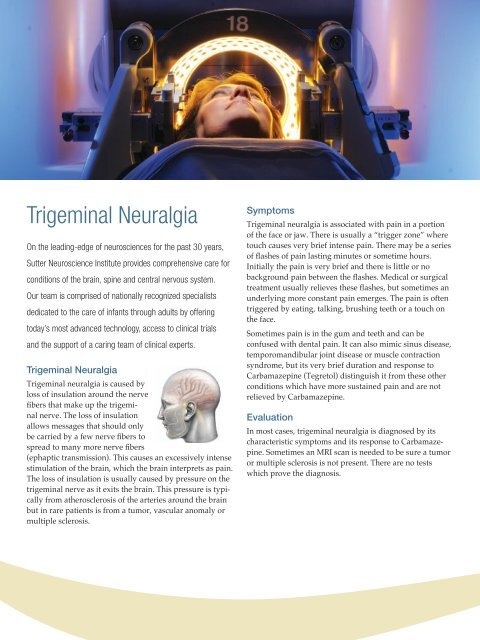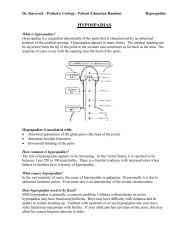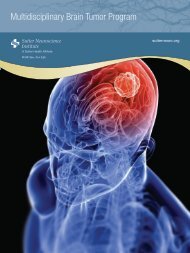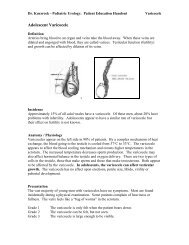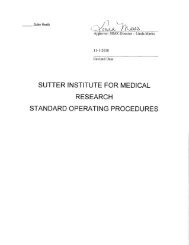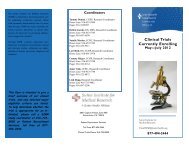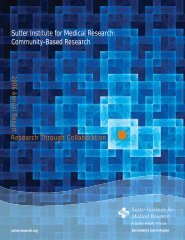Sutter Neuroscience Trigeminal Neuralgia - Sutter Health ...
Sutter Neuroscience Trigeminal Neuralgia - Sutter Health ...
Sutter Neuroscience Trigeminal Neuralgia - Sutter Health ...
You also want an ePaper? Increase the reach of your titles
YUMPU automatically turns print PDFs into web optimized ePapers that Google loves.
<strong>Trigeminal</strong> <strong>Neuralgia</strong><br />
On the leading-edge of neurosciences for the past 30 years,<br />
<strong>Sutter</strong> <strong>Neuroscience</strong> Institute provides comprehensive care for<br />
conditions of the brain, spine and central nervous system.<br />
Our team is comprised of nationally recognized specialists<br />
dedicated to the care of infants through adults by offering<br />
today’s most advanced technology, access to clinical trials<br />
and the support of a caring team of clinical experts.<br />
<strong>Trigeminal</strong> <strong>Neuralgia</strong><br />
<strong>Trigeminal</strong> neuralgia is caused by<br />
loss of insulation around the nerve<br />
fibers that make up the trigeminal<br />
nerve. The loss of insulation<br />
allows messages that should only<br />
be carried by a few nerve fibers to<br />
spread to many more nerve fibers<br />
(ephaptic transmission). This causes an excessively intense<br />
stimulation of the brain, which the brain interprets as pain.<br />
The loss of insulation is usually caused by pressure on the<br />
trigeminal nerve as it exits the brain. This pressure is typically<br />
from atherosclerosis of the arteries around the brain<br />
but in rare patients is from a tumor, vascular anomaly or<br />
multiple sclerosis.<br />
Symptoms<br />
<strong>Trigeminal</strong> neuralgia is associated with pain in a portion<br />
of the face or jaw. There is usually a “trigger zone” where<br />
touch causes very brief intense pain. There may be a series<br />
of flashes of pain lasting minutes or sometime hours.<br />
Initially the pain is very brief and there is little or no<br />
background pain between the flashes. Medical or surgical<br />
treatment usually relieves these flashes, but sometimes an<br />
underlying more constant pain emerges. The pain is often<br />
triggered by eating, talking, brushing teeth or a touch on<br />
the face.<br />
Sometimes pain is in the gum and teeth and can be<br />
confused with dental pain. It can also mimic sinus disease,<br />
temporomandibular joint disease or muscle contraction<br />
syndrome, but its very brief duration and response to<br />
Carbamazepine (Tegretol) distinguish it from these other<br />
conditions which have more sustained pain and are not<br />
relieved by Carbamazepine.<br />
Evaluation<br />
In most cases, trigeminal neuralgia is diagnosed by its<br />
characteristic symptoms and its response to Carbamazepine.<br />
Sometimes an MRI scan is needed to be sure a tumor<br />
or multiple sclerosis is not present. There are no tests<br />
which prove the diagnosis.


